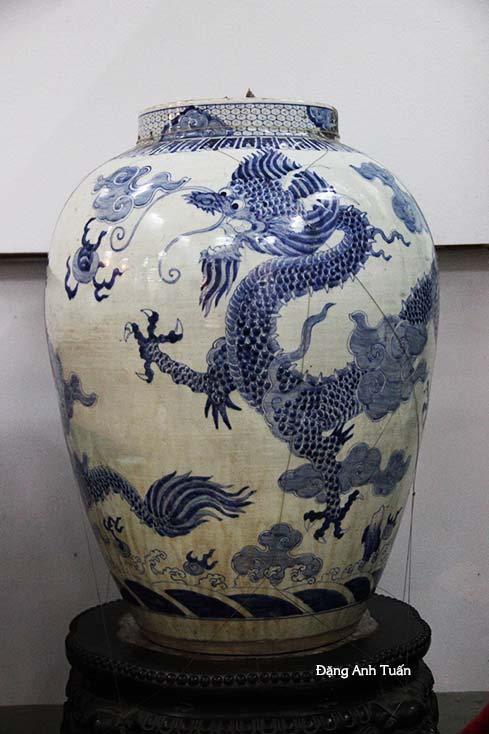Version française
Version vietnamienne
There are neither Vietnamese tales nor legends without this fabulous and mythical animal that is commonly called Con Rồng or more literary Con Long (or the Dragon in English). It makes part of the four animals with supernatural power (Tứ Linh) and occupies the top place. It is frequently used in Vietnamese art. It is not only seen in pagodas, but also on the ridges of roofs, the beams of frames, furnitures, the pieces of dishes and fabrics. It is also the emblematic animal traditionally chosen by the emperor for his clothes.
All Vietnamese firmly believe they are descendents of the Dragon king Lạc Long Quân coming from the Waters and of the fairy Âu Cơ of terrestrial origins. From this union, the fairy laid one hundred eggs that gave birth to one hundred robust sons. Later, at the separation of the couple, fifty of them followed their father Dragon toward the lower coastal regions and founded the first Vietnamese nation named Văn Lang while the other fifty followed their terrestrial mother toward the high plains to give birth later to an ethnic microcosm the most complex in the world ( about fifty groups ). Although this version of the Seven Tribes of Israel is unbridled and poetic, it nevertheless allows the Vietnamese and other minority groups to live together somewhat peacefully in this country of the form of the dragon, and to unite as a sole person to overcome foreign aggressors in difficult moments of their history.
According to a Vietnamese legend, it was thanks to the return of a benefactor dragon that barbarous hordes coming from the North were routed. Its fire spitting tongues on contact with the sea turned into a multitude of small islands and reefs with extravagant forms. That is why this bay is known in Vietnamese as « Hạ Long » or ( Descending Dragon ). It becomes thus the eighth marvel of the world and a natural site the most visited by foreign tourists when they land in Vietnam.
Hạ Long Bay
The dragon is also the symbol of the King. That is why its feet must have five claws. If one sees a dragon with five claws on a furniture, a box or a china, this object is meant for the service of the emperor. Otherwise the dragon generally has only four claws.
It is also the symbol of the husband, the fiance and more generally the man. As for the woman, she is represented by the phenix. That is why when we want to make allusion to a marriage, we often associate a dragon with a phenix on a piece of embroidery or a sculpted panel. It is also this association that poets evoke in their poems to talk about marital happiness and shared joy.
The dragon is seen everywhere even in the Mekong delta. This river born in the foothills of the Himalayas ( Tibet ) divides into nine branches or nine dragons to throw itself in the golf of Cochinchina ( or Nam Bộ ). That is why this region is called Cửu Long ( or Nine Dragons in English).
If this marine monster is rebutted by the majority of the peoples, it is on the contrary, a part of the Vietnamese daily life. It is assigned to keep an watchful eye, at the imperial city of Huế, on the tombs of the Nguyễn emperors with all its body made of multicolored ceramic pieces. Golden, it coils around the carmine lacquered pillars of imperial palaces. It is one of the twelve astrological signs of the lunar calendar. It becomes not only the embroided silk clothes for tourists but also a front part sign with gaudy colors on the junks of the Hạ Long bay.
In the cradle of legends that is our Vietnam, we have the feeling of being better protected by this marine monster because we are convinced that we are the descendents of king Dragon.


